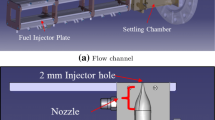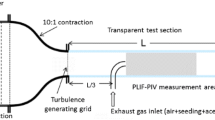Abstract
The transient injection and mixing between nitrogen and helium in a confined chamber at atmospheric pressure is studied experimentally. The 2D injector and mixing chamber contained a middle injection slot for nitrogen flanked by a pair of outer slots for helium. Experiments were conducted by introducing the helium streams into a previously established quasi-steady flow of nitrogen. The nitrogen stream was seeded with nitric oxide (NO) that served as a source for quantitative, planar laser-induced fluorescence (PLIF) imaging of the transient mixing process. PLIF images were acquired by triggering an Nd:YAG laser system at selected times following helium valve actuation. The observed flow structures and extent of mixing between the two streams proved to be highly unsteady and irregular with the helium/nitrogen jets frequently deviating from the centerline toward the confining walls. Representative unsteady CFD solutions also show this same absence of symmetry and the same general flow structures as the measurements, however, they predict somewhat higher helium concentration in recirculation regions than were observed in the measurements.


















Similar content being viewed by others
References
Back LH and Roschke EJ (1972) Shear-layer flow regimes and wave instabilities and reattachment lengths downstream of an abrupt circular channel expansion. J Appl Mech 39(3):677–681
Battles BE, Hanson RK (1995) Laser-induced fluorescence measurements of NO and OH mole fraction in fuel-lean, high-pressure (1-10 atm) methane flames: fluorescence modeling and experimental validation. J Quant Spectrosc Radiat Transf 54(3):521–537
Bernal LP (1988) The statistics of the organized vortical structure in turbulent mixing layers. Phys Fluids 31:2533–43
Bessler WG, Schulz C, Lee T, Shin D-T, Hofmann M, Jeffries JB, Wolfrum J, Hanson RK (2002) Quantitative NO-LIF imaging in high-pressure flames. Appl Phys B 75:97–102
Broadwell JE, Mungal MG (1991) Large-scale structures and molecular mixing. Phys Fluids 3:1193–206
Brown GL, Roshko A (1974) On density effects and large structure in turbulent mixing layer. J Fluid Mech 64:775–816
Cook AW, Dimotakis PE (2001) Transition stages of Rayleigh-Taylor instability between miscible fluids. J Fluid Mech 443:69–99
Dimonte G, Schneider M (2000) Density ratio dependence of Rayleigh-Taylor mixing for sustained and impulsive acceleration histories. Phys Fluids 12:304–21
Dimotakis PE (2005) Turbulent mixing. Annu Rev Fluid Mech 37:329–356
Hensel C, Wiemann D, Oechslein W, Görgen J (2002) Ignition aspects for the vinci thrust chamber. AIAA paper 2002–4008
Huerre P, Monkewitz PA. (1990) Local and global instabilities in spatially developing flows. Annu Rev Fluid Mech 22:473– 537
Johnson BV, Bennett JC (1981) Mass and momentum turbulent transport experiments with confined coaxial jets. NASA contractor report, CR-165574, UTRC report R81-915540-9
Li D, Sankaran V, Merkle CL, Lindau J (2005) A unified computational formulation for multi-component and multi-phase flows. AIAA paper 2005–1391
Martin GC, Mueller CJ, Lee C-FF (2006) Two-photon nitric-oxide planar laser-induced fluorescence in a diesel engine. Appl Optics 45(9):2089–2100
McManus K, Aguerre F, Yip B and Candel S (1994) Analysis of the ignition sequence of a multiple injector combustor using PLIF imaging, non-intrusive combustion diagnostics. In: Kuo K, Parr T (Eds) Begell House, USA
Meyer TR, Dutton JC, Lucht LP (2001) Experimental study of the mixing transition in a gaseous axisymmetric jet. Phys Fluid 13(11):3411–3424
Meyer TR, King GF, Martin GC, Lucht RP, Schauer FR, JC Dutton JC (2002) Accuracy and resolution issues in NO/acetone PLIF measurements of gas-phase molecular mixing. Exp Fluid 32:603–611
Miller MF, Bowman CT, Mungal MG (1998) An experimental investigation of the effects of compressibility on a turbulent reacting mixing layer. J Fluid Mech 356:25–64
Rossmann T, Mungal MG, Hanson RK (2003) Nitric-oxide planar laser-induced fluorescence applied to low-pressure hypersonic flow fields for the imaging of mixing fraction. Appl Optics 42(33):6682–6695
Sankaran V, Merkle CL (2003) Artificial dissipation control for unsteady computations. AIAA paper 2003–3695
Schmidt V, Klimenko D, Haidn O, Oschwald M, Nicole A, Ordonneau G, Habiballah M (2003) Experimental investigation and modeling of the ignition transient of a coaxial H2/O2-Injector. In: Proceedings of 5th international symposium on space propulsion. Chattanooga
Slessor MD, Bond CL, Dimotakis PE (1998) Turbulent shear-layer mixing at high Reynolds numbers: effects of inflow conditions. J Fluid Mech 376:115–38
Wang GR (2006) On large structures and turbulent mixing in confined mixing layers under forcing. AIChE J 52(1):111–124
Wilcox DC (1998) Turbulence modeling for CFD, 2nd edn. DCW Industries, La Canada
Acknowledgments
This project is supported by the NASA Constellation University Institutes Project (CUIP) Program under Grant NCC8-200 with Ms. Claudia Meyer and Dr. Jeff Rybak of Glenn Research Center as contract monitors. The funding for the fabrication of the injector assembly and for the initial measurements was provided by the NASA Combustion Devices Injector Technology (CDIT) Program. The substantial efforts of Dr. James Sisco and Dr. William Anderson (Purdue) in designing the injector, and of Dr. Thomas Anderson (Purdue) in developing the LabVIEW program are gratefully acknowledged.
Author information
Authors and Affiliations
Corresponding author
Rights and permissions
About this article
Cite this article
Tseng, C.C., Voytovych, D.M., Kulatilaka, W.D. et al. Structure and mixing of a transient flow of helium injected into an established flow of nitrogen: two dimensional measurement and simulation. Exp Fluids 46, 559–575 (2009). https://doi.org/10.1007/s00348-008-0581-6
Received:
Revised:
Accepted:
Published:
Issue Date:
DOI: https://doi.org/10.1007/s00348-008-0581-6




